British Colonization: Effects on Indigenous Community Structure
VerifiedAdded on 2023/06/03
|10
|2521
|334
Essay
AI Summary
This essay examines the profound impact of British colonization on Indigenous Australian community structure, focusing on critical issues such as cultural destruction, land dispossession, and the introduction of diseases. It analyzes the disruption of traditional lifestyles and the forced assimilation policies implemented by the British, leading to significant loss of identity and cultural heritage. The essay further explores the consequences of these policies, including family separation and massacres, while also considering the resilience and adaptability of Indigenous Australians. It also discusses the introduction of alcohol and its detrimental effects. Recommendations are provided for maintaining cultural connections and promoting culturally oriented social well-being, and the essay concludes by emphasizing the importance of understanding historical injustices and fostering reconciliation. Desklib offers more resources for students, including similar essays and study tools.
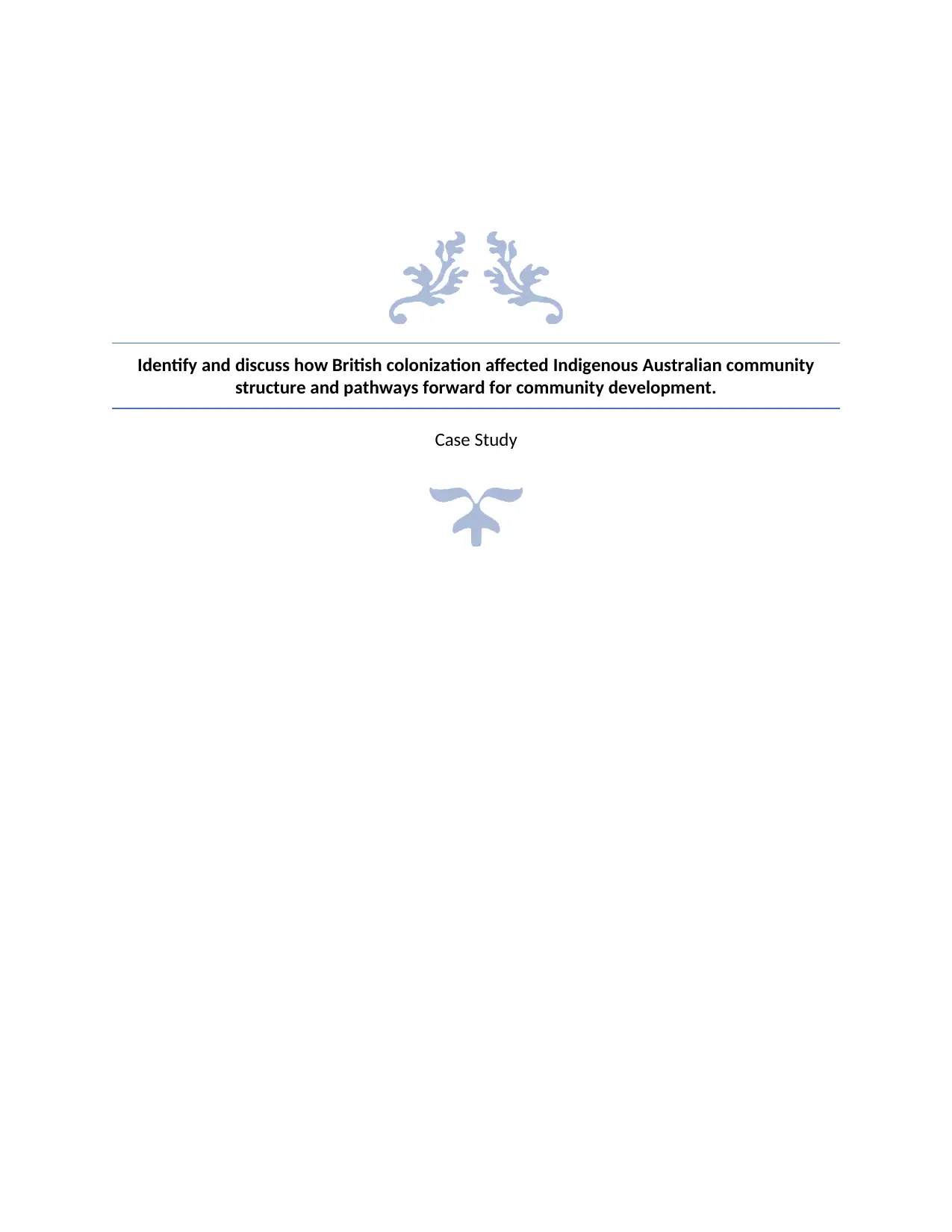
Identify and discuss how British colonization affected Indigenous Australian community
structure and pathways forward for community development.
Case Study
structure and pathways forward for community development.
Case Study
Paraphrase This Document
Need a fresh take? Get an instant paraphrase of this document with our AI Paraphraser
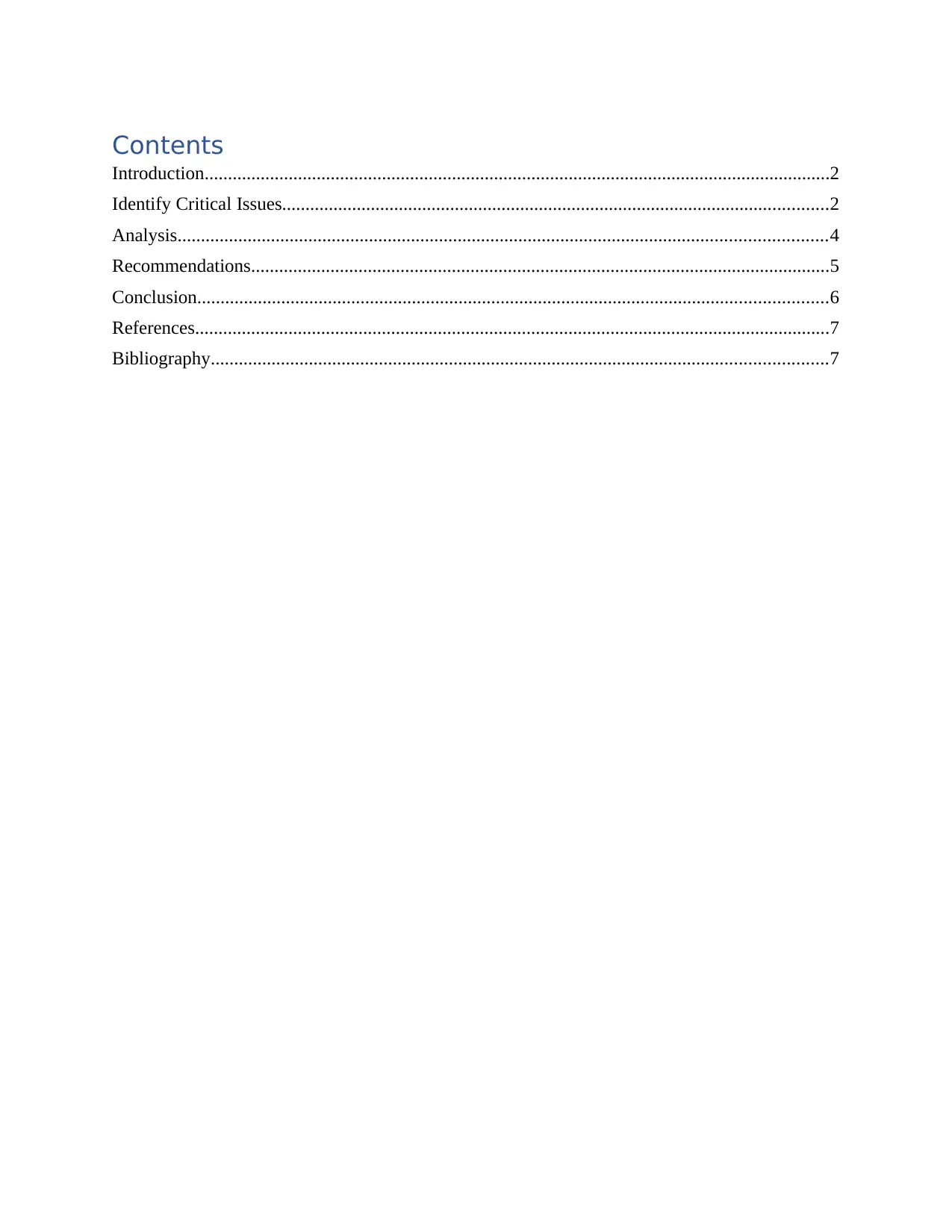
Contents
Introduction......................................................................................................................................2
Identify Critical Issues.....................................................................................................................2
Analysis...........................................................................................................................................4
Recommendations............................................................................................................................5
Conclusion.......................................................................................................................................6
References........................................................................................................................................7
Bibliography....................................................................................................................................7
Introduction......................................................................................................................................2
Identify Critical Issues.....................................................................................................................2
Analysis...........................................................................................................................................4
Recommendations............................................................................................................................5
Conclusion.......................................................................................................................................6
References........................................................................................................................................7
Bibliography....................................................................................................................................7
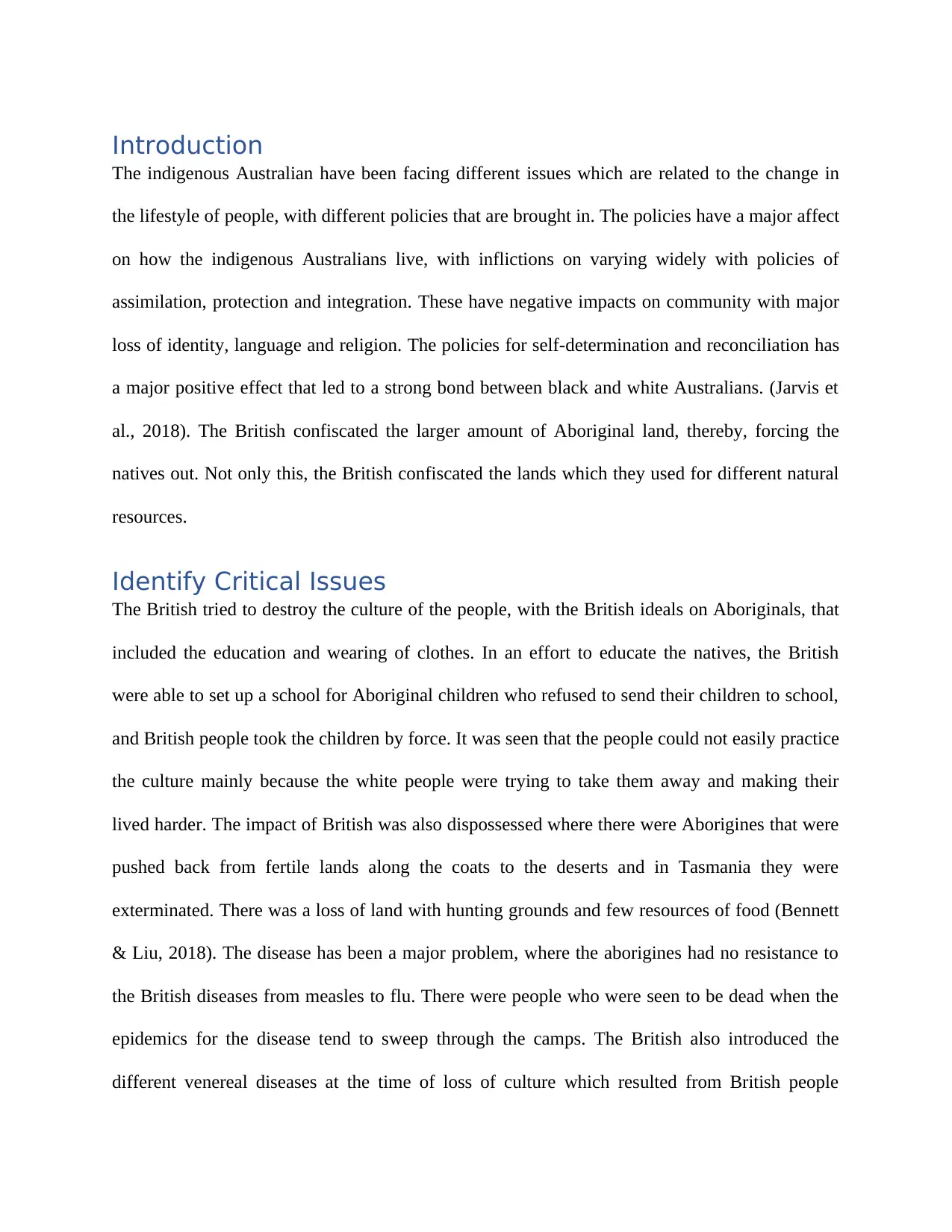
Introduction
The indigenous Australian have been facing different issues which are related to the change in
the lifestyle of people, with different policies that are brought in. The policies have a major affect
on how the indigenous Australians live, with inflictions on varying widely with policies of
assimilation, protection and integration. These have negative impacts on community with major
loss of identity, language and religion. The policies for self-determination and reconciliation has
a major positive effect that led to a strong bond between black and white Australians. (Jarvis et
al., 2018). The British confiscated the larger amount of Aboriginal land, thereby, forcing the
natives out. Not only this, the British confiscated the lands which they used for different natural
resources.
Identify Critical Issues
The British tried to destroy the culture of the people, with the British ideals on Aboriginals, that
included the education and wearing of clothes. In an effort to educate the natives, the British
were able to set up a school for Aboriginal children who refused to send their children to school,
and British people took the children by force. It was seen that the people could not easily practice
the culture mainly because the white people were trying to take them away and making their
lived harder. The impact of British was also dispossessed where there were Aborigines that were
pushed back from fertile lands along the coats to the deserts and in Tasmania they were
exterminated. There was a loss of land with hunting grounds and few resources of food (Bennett
& Liu, 2018). The disease has been a major problem, where the aborigines had no resistance to
the British diseases from measles to flu. There were people who were seen to be dead when the
epidemics for the disease tend to sweep through the camps. The British also introduced the
different venereal diseases at the time of loss of culture which resulted from British people
The indigenous Australian have been facing different issues which are related to the change in
the lifestyle of people, with different policies that are brought in. The policies have a major affect
on how the indigenous Australians live, with inflictions on varying widely with policies of
assimilation, protection and integration. These have negative impacts on community with major
loss of identity, language and religion. The policies for self-determination and reconciliation has
a major positive effect that led to a strong bond between black and white Australians. (Jarvis et
al., 2018). The British confiscated the larger amount of Aboriginal land, thereby, forcing the
natives out. Not only this, the British confiscated the lands which they used for different natural
resources.
Identify Critical Issues
The British tried to destroy the culture of the people, with the British ideals on Aboriginals, that
included the education and wearing of clothes. In an effort to educate the natives, the British
were able to set up a school for Aboriginal children who refused to send their children to school,
and British people took the children by force. It was seen that the people could not easily practice
the culture mainly because the white people were trying to take them away and making their
lived harder. The impact of British was also dispossessed where there were Aborigines that were
pushed back from fertile lands along the coats to the deserts and in Tasmania they were
exterminated. There was a loss of land with hunting grounds and few resources of food (Bennett
& Liu, 2018). The disease has been a major problem, where the aborigines had no resistance to
the British diseases from measles to flu. There were people who were seen to be dead when the
epidemics for the disease tend to sweep through the camps. The British also introduced the
different venereal diseases at the time of loss of culture which resulted from British people
⊘ This is a preview!⊘
Do you want full access?
Subscribe today to unlock all pages.

Trusted by 1+ million students worldwide
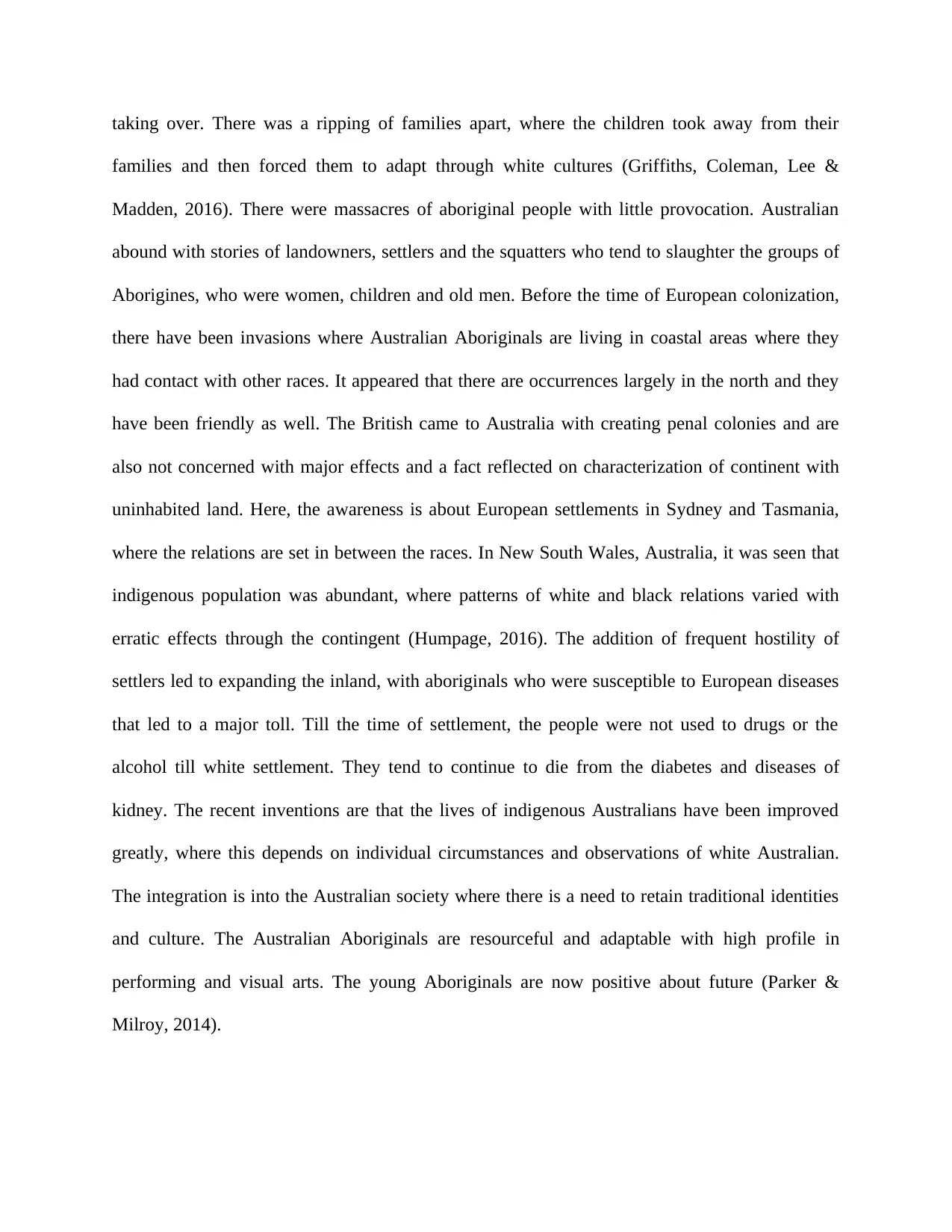
taking over. There was a ripping of families apart, where the children took away from their
families and then forced them to adapt through white cultures (Griffiths, Coleman, Lee &
Madden, 2016). There were massacres of aboriginal people with little provocation. Australian
abound with stories of landowners, settlers and the squatters who tend to slaughter the groups of
Aborigines, who were women, children and old men. Before the time of European colonization,
there have been invasions where Australian Aboriginals are living in coastal areas where they
had contact with other races. It appeared that there are occurrences largely in the north and they
have been friendly as well. The British came to Australia with creating penal colonies and are
also not concerned with major effects and a fact reflected on characterization of continent with
uninhabited land. Here, the awareness is about European settlements in Sydney and Tasmania,
where the relations are set in between the races. In New South Wales, Australia, it was seen that
indigenous population was abundant, where patterns of white and black relations varied with
erratic effects through the contingent (Humpage, 2016). The addition of frequent hostility of
settlers led to expanding the inland, with aboriginals who were susceptible to European diseases
that led to a major toll. Till the time of settlement, the people were not used to drugs or the
alcohol till white settlement. They tend to continue to die from the diabetes and diseases of
kidney. The recent inventions are that the lives of indigenous Australians have been improved
greatly, where this depends on individual circumstances and observations of white Australian.
The integration is into the Australian society where there is a need to retain traditional identities
and culture. The Australian Aboriginals are resourceful and adaptable with high profile in
performing and visual arts. The young Aboriginals are now positive about future (Parker &
Milroy, 2014).
families and then forced them to adapt through white cultures (Griffiths, Coleman, Lee &
Madden, 2016). There were massacres of aboriginal people with little provocation. Australian
abound with stories of landowners, settlers and the squatters who tend to slaughter the groups of
Aborigines, who were women, children and old men. Before the time of European colonization,
there have been invasions where Australian Aboriginals are living in coastal areas where they
had contact with other races. It appeared that there are occurrences largely in the north and they
have been friendly as well. The British came to Australia with creating penal colonies and are
also not concerned with major effects and a fact reflected on characterization of continent with
uninhabited land. Here, the awareness is about European settlements in Sydney and Tasmania,
where the relations are set in between the races. In New South Wales, Australia, it was seen that
indigenous population was abundant, where patterns of white and black relations varied with
erratic effects through the contingent (Humpage, 2016). The addition of frequent hostility of
settlers led to expanding the inland, with aboriginals who were susceptible to European diseases
that led to a major toll. Till the time of settlement, the people were not used to drugs or the
alcohol till white settlement. They tend to continue to die from the diabetes and diseases of
kidney. The recent inventions are that the lives of indigenous Australians have been improved
greatly, where this depends on individual circumstances and observations of white Australian.
The integration is into the Australian society where there is a need to retain traditional identities
and culture. The Australian Aboriginals are resourceful and adaptable with high profile in
performing and visual arts. The young Aboriginals are now positive about future (Parker &
Milroy, 2014).
Paraphrase This Document
Need a fresh take? Get an instant paraphrase of this document with our AI Paraphraser
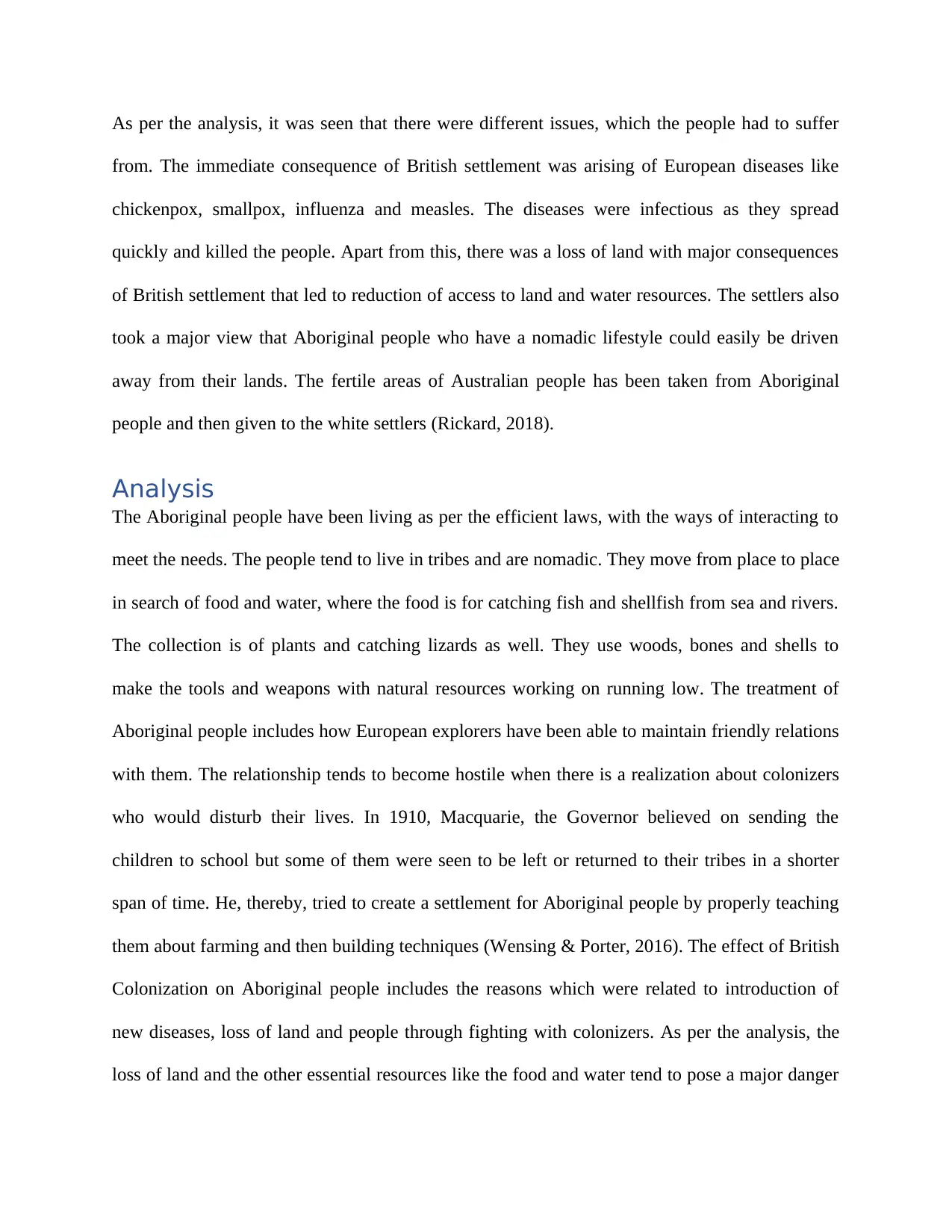
As per the analysis, it was seen that there were different issues, which the people had to suffer
from. The immediate consequence of British settlement was arising of European diseases like
chickenpox, smallpox, influenza and measles. The diseases were infectious as they spread
quickly and killed the people. Apart from this, there was a loss of land with major consequences
of British settlement that led to reduction of access to land and water resources. The settlers also
took a major view that Aboriginal people who have a nomadic lifestyle could easily be driven
away from their lands. The fertile areas of Australian people has been taken from Aboriginal
people and then given to the white settlers (Rickard, 2018).
Analysis
The Aboriginal people have been living as per the efficient laws, with the ways of interacting to
meet the needs. The people tend to live in tribes and are nomadic. They move from place to place
in search of food and water, where the food is for catching fish and shellfish from sea and rivers.
The collection is of plants and catching lizards as well. They use woods, bones and shells to
make the tools and weapons with natural resources working on running low. The treatment of
Aboriginal people includes how European explorers have been able to maintain friendly relations
with them. The relationship tends to become hostile when there is a realization about colonizers
who would disturb their lives. In 1910, Macquarie, the Governor believed on sending the
children to school but some of them were seen to be left or returned to their tribes in a shorter
span of time. He, thereby, tried to create a settlement for Aboriginal people by properly teaching
them about farming and then building techniques (Wensing & Porter, 2016). The effect of British
Colonization on Aboriginal people includes the reasons which were related to introduction of
new diseases, loss of land and people through fighting with colonizers. As per the analysis, the
loss of land and the other essential resources like the food and water tend to pose a major danger
from. The immediate consequence of British settlement was arising of European diseases like
chickenpox, smallpox, influenza and measles. The diseases were infectious as they spread
quickly and killed the people. Apart from this, there was a loss of land with major consequences
of British settlement that led to reduction of access to land and water resources. The settlers also
took a major view that Aboriginal people who have a nomadic lifestyle could easily be driven
away from their lands. The fertile areas of Australian people has been taken from Aboriginal
people and then given to the white settlers (Rickard, 2018).
Analysis
The Aboriginal people have been living as per the efficient laws, with the ways of interacting to
meet the needs. The people tend to live in tribes and are nomadic. They move from place to place
in search of food and water, where the food is for catching fish and shellfish from sea and rivers.
The collection is of plants and catching lizards as well. They use woods, bones and shells to
make the tools and weapons with natural resources working on running low. The treatment of
Aboriginal people includes how European explorers have been able to maintain friendly relations
with them. The relationship tends to become hostile when there is a realization about colonizers
who would disturb their lives. In 1910, Macquarie, the Governor believed on sending the
children to school but some of them were seen to be left or returned to their tribes in a shorter
span of time. He, thereby, tried to create a settlement for Aboriginal people by properly teaching
them about farming and then building techniques (Wensing & Porter, 2016). The effect of British
Colonization on Aboriginal people includes the reasons which were related to introduction of
new diseases, loss of land and people through fighting with colonizers. As per the analysis, the
loss of land and the other essential resources like the food and water tend to pose a major danger
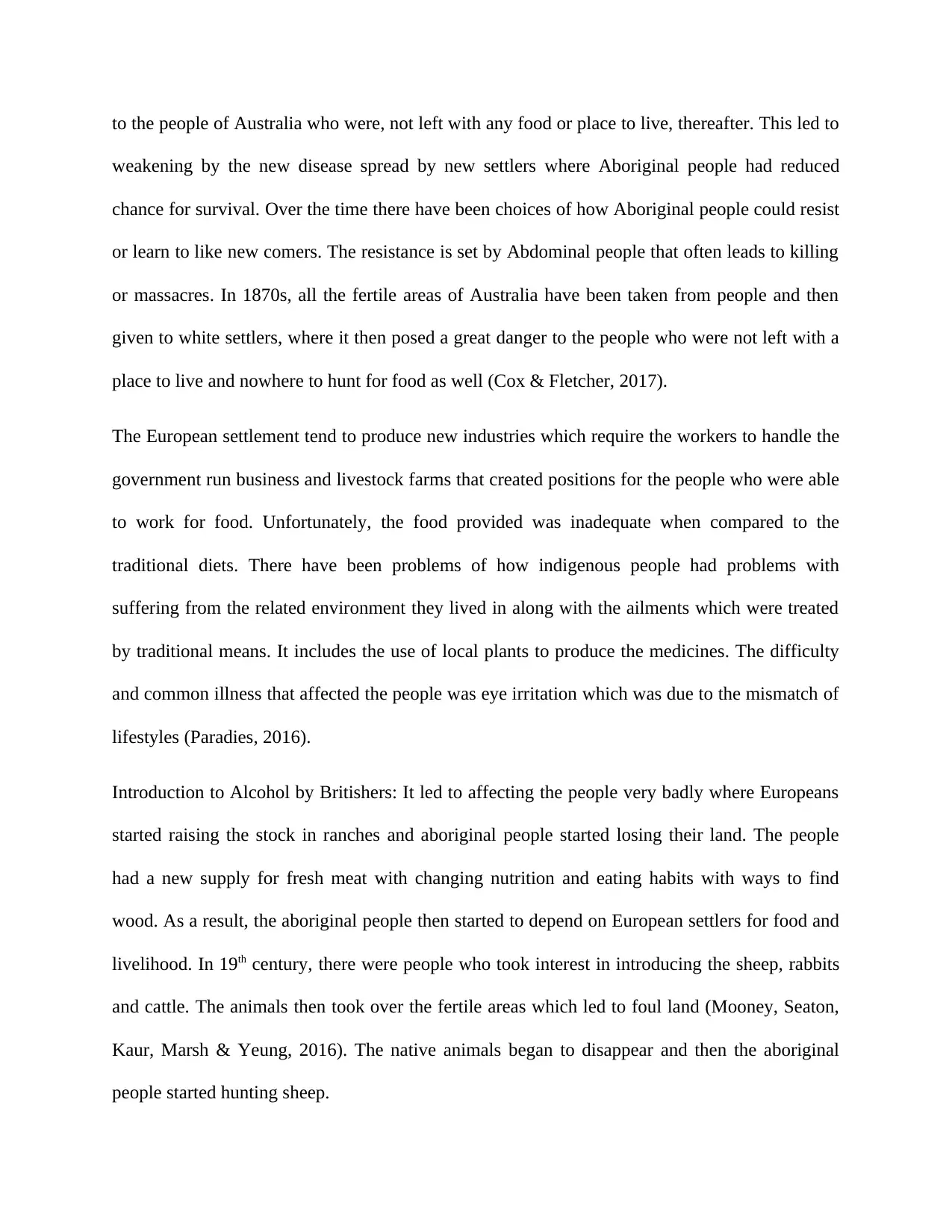
to the people of Australia who were, not left with any food or place to live, thereafter. This led to
weakening by the new disease spread by new settlers where Aboriginal people had reduced
chance for survival. Over the time there have been choices of how Aboriginal people could resist
or learn to like new comers. The resistance is set by Abdominal people that often leads to killing
or massacres. In 1870s, all the fertile areas of Australia have been taken from people and then
given to white settlers, where it then posed a great danger to the people who were not left with a
place to live and nowhere to hunt for food as well (Cox & Fletcher, 2017).
The European settlement tend to produce new industries which require the workers to handle the
government run business and livestock farms that created positions for the people who were able
to work for food. Unfortunately, the food provided was inadequate when compared to the
traditional diets. There have been problems of how indigenous people had problems with
suffering from the related environment they lived in along with the ailments which were treated
by traditional means. It includes the use of local plants to produce the medicines. The difficulty
and common illness that affected the people was eye irritation which was due to the mismatch of
lifestyles (Paradies, 2016).
Introduction to Alcohol by Britishers: It led to affecting the people very badly where Europeans
started raising the stock in ranches and aboriginal people started losing their land. The people
had a new supply for fresh meat with changing nutrition and eating habits with ways to find
wood. As a result, the aboriginal people then started to depend on European settlers for food and
livelihood. In 19th century, there were people who took interest in introducing the sheep, rabbits
and cattle. The animals then took over the fertile areas which led to foul land (Mooney, Seaton,
Kaur, Marsh & Yeung, 2016). The native animals began to disappear and then the aboriginal
people started hunting sheep.
weakening by the new disease spread by new settlers where Aboriginal people had reduced
chance for survival. Over the time there have been choices of how Aboriginal people could resist
or learn to like new comers. The resistance is set by Abdominal people that often leads to killing
or massacres. In 1870s, all the fertile areas of Australia have been taken from people and then
given to white settlers, where it then posed a great danger to the people who were not left with a
place to live and nowhere to hunt for food as well (Cox & Fletcher, 2017).
The European settlement tend to produce new industries which require the workers to handle the
government run business and livestock farms that created positions for the people who were able
to work for food. Unfortunately, the food provided was inadequate when compared to the
traditional diets. There have been problems of how indigenous people had problems with
suffering from the related environment they lived in along with the ailments which were treated
by traditional means. It includes the use of local plants to produce the medicines. The difficulty
and common illness that affected the people was eye irritation which was due to the mismatch of
lifestyles (Paradies, 2016).
Introduction to Alcohol by Britishers: It led to affecting the people very badly where Europeans
started raising the stock in ranches and aboriginal people started losing their land. The people
had a new supply for fresh meat with changing nutrition and eating habits with ways to find
wood. As a result, the aboriginal people then started to depend on European settlers for food and
livelihood. In 19th century, there were people who took interest in introducing the sheep, rabbits
and cattle. The animals then took over the fertile areas which led to foul land (Mooney, Seaton,
Kaur, Marsh & Yeung, 2016). The native animals began to disappear and then the aboriginal
people started hunting sheep.
⊘ This is a preview!⊘
Do you want full access?
Subscribe today to unlock all pages.

Trusted by 1+ million students worldwide
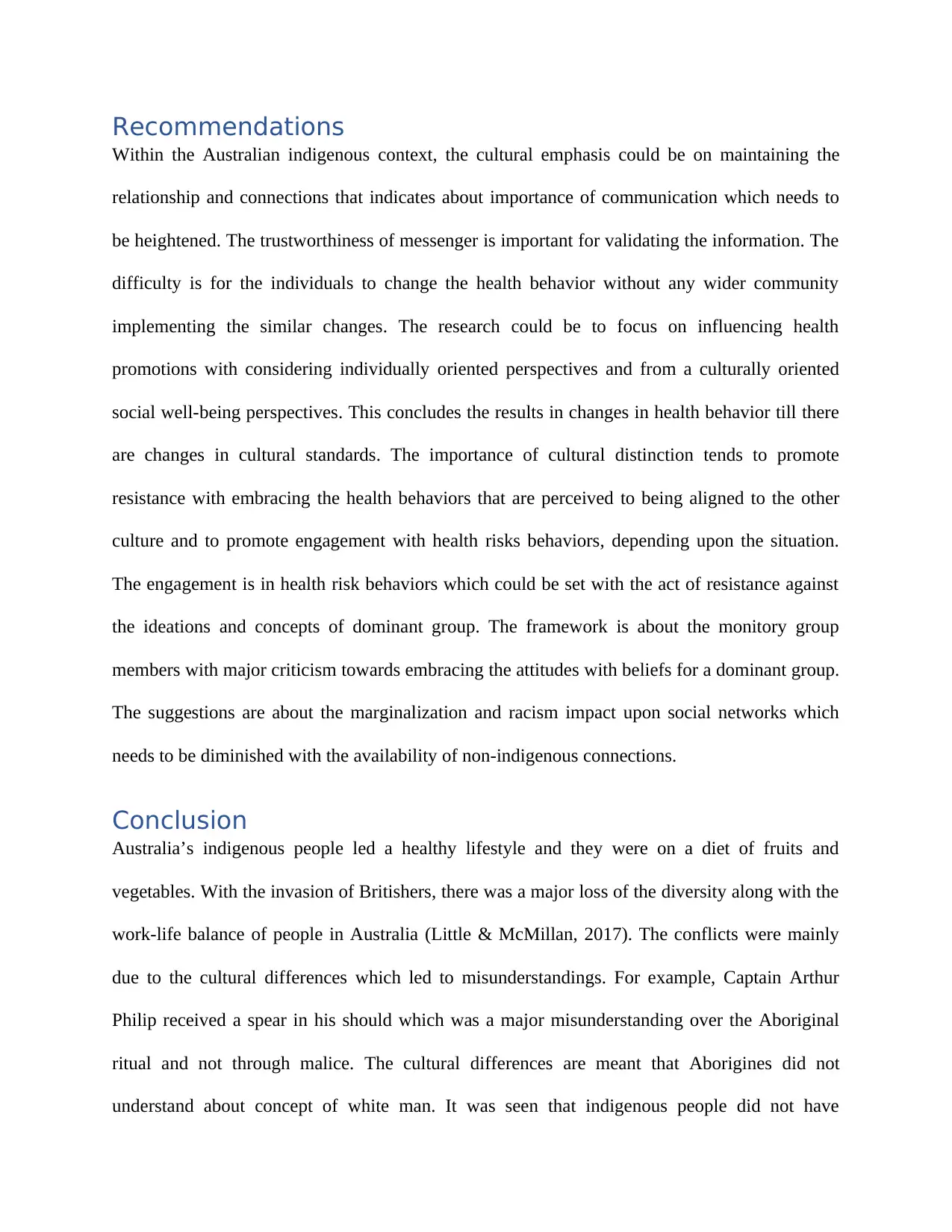
Recommendations
Within the Australian indigenous context, the cultural emphasis could be on maintaining the
relationship and connections that indicates about importance of communication which needs to
be heightened. The trustworthiness of messenger is important for validating the information. The
difficulty is for the individuals to change the health behavior without any wider community
implementing the similar changes. The research could be to focus on influencing health
promotions with considering individually oriented perspectives and from a culturally oriented
social well-being perspectives. This concludes the results in changes in health behavior till there
are changes in cultural standards. The importance of cultural distinction tends to promote
resistance with embracing the health behaviors that are perceived to being aligned to the other
culture and to promote engagement with health risks behaviors, depending upon the situation.
The engagement is in health risk behaviors which could be set with the act of resistance against
the ideations and concepts of dominant group. The framework is about the monitory group
members with major criticism towards embracing the attitudes with beliefs for a dominant group.
The suggestions are about the marginalization and racism impact upon social networks which
needs to be diminished with the availability of non-indigenous connections.
Conclusion
Australia’s indigenous people led a healthy lifestyle and they were on a diet of fruits and
vegetables. With the invasion of Britishers, there was a major loss of the diversity along with the
work-life balance of people in Australia (Little & McMillan, 2017). The conflicts were mainly
due to the cultural differences which led to misunderstandings. For example, Captain Arthur
Philip received a spear in his should which was a major misunderstanding over the Aboriginal
ritual and not through malice. The cultural differences are meant that Aborigines did not
understand about concept of white man. It was seen that indigenous people did not have
Within the Australian indigenous context, the cultural emphasis could be on maintaining the
relationship and connections that indicates about importance of communication which needs to
be heightened. The trustworthiness of messenger is important for validating the information. The
difficulty is for the individuals to change the health behavior without any wider community
implementing the similar changes. The research could be to focus on influencing health
promotions with considering individually oriented perspectives and from a culturally oriented
social well-being perspectives. This concludes the results in changes in health behavior till there
are changes in cultural standards. The importance of cultural distinction tends to promote
resistance with embracing the health behaviors that are perceived to being aligned to the other
culture and to promote engagement with health risks behaviors, depending upon the situation.
The engagement is in health risk behaviors which could be set with the act of resistance against
the ideations and concepts of dominant group. The framework is about the monitory group
members with major criticism towards embracing the attitudes with beliefs for a dominant group.
The suggestions are about the marginalization and racism impact upon social networks which
needs to be diminished with the availability of non-indigenous connections.
Conclusion
Australia’s indigenous people led a healthy lifestyle and they were on a diet of fruits and
vegetables. With the invasion of Britishers, there was a major loss of the diversity along with the
work-life balance of people in Australia (Little & McMillan, 2017). The conflicts were mainly
due to the cultural differences which led to misunderstandings. For example, Captain Arthur
Philip received a spear in his should which was a major misunderstanding over the Aboriginal
ritual and not through malice. The cultural differences are meant that Aborigines did not
understand about concept of white man. It was seen that indigenous people did not have
Paraphrase This Document
Need a fresh take? Get an instant paraphrase of this document with our AI Paraphraser
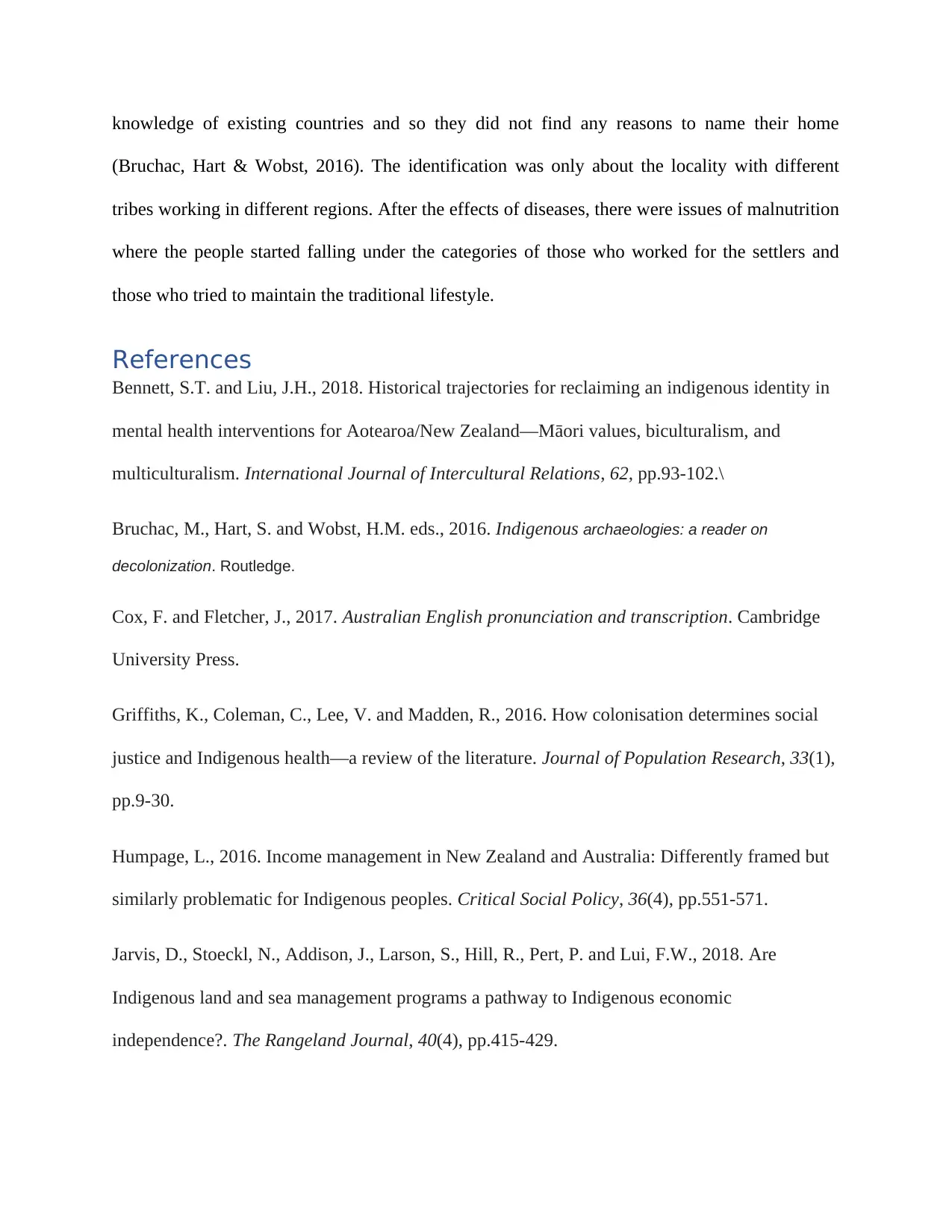
knowledge of existing countries and so they did not find any reasons to name their home
(Bruchac, Hart & Wobst, 2016). The identification was only about the locality with different
tribes working in different regions. After the effects of diseases, there were issues of malnutrition
where the people started falling under the categories of those who worked for the settlers and
those who tried to maintain the traditional lifestyle.
References
Bennett, S.T. and Liu, J.H., 2018. Historical trajectories for reclaiming an indigenous identity in
mental health interventions for Aotearoa/New Zealand—Māori values, biculturalism, and
multiculturalism. International Journal of Intercultural Relations, 62, pp.93-102.\
Bruchac, M., Hart, S. and Wobst, H.M. eds., 2016. Indigenous archaeologies: a reader on
decolonization. Routledge.
Cox, F. and Fletcher, J., 2017. Australian English pronunciation and transcription. Cambridge
University Press.
Griffiths, K., Coleman, C., Lee, V. and Madden, R., 2016. How colonisation determines social
justice and Indigenous health—a review of the literature. Journal of Population Research, 33(1),
pp.9-30.
Humpage, L., 2016. Income management in New Zealand and Australia: Differently framed but
similarly problematic for Indigenous peoples. Critical Social Policy, 36(4), pp.551-571.
Jarvis, D., Stoeckl, N., Addison, J., Larson, S., Hill, R., Pert, P. and Lui, F.W., 2018. Are
Indigenous land and sea management programs a pathway to Indigenous economic
independence?. The Rangeland Journal, 40(4), pp.415-429.
(Bruchac, Hart & Wobst, 2016). The identification was only about the locality with different
tribes working in different regions. After the effects of diseases, there were issues of malnutrition
where the people started falling under the categories of those who worked for the settlers and
those who tried to maintain the traditional lifestyle.
References
Bennett, S.T. and Liu, J.H., 2018. Historical trajectories for reclaiming an indigenous identity in
mental health interventions for Aotearoa/New Zealand—Māori values, biculturalism, and
multiculturalism. International Journal of Intercultural Relations, 62, pp.93-102.\
Bruchac, M., Hart, S. and Wobst, H.M. eds., 2016. Indigenous archaeologies: a reader on
decolonization. Routledge.
Cox, F. and Fletcher, J., 2017. Australian English pronunciation and transcription. Cambridge
University Press.
Griffiths, K., Coleman, C., Lee, V. and Madden, R., 2016. How colonisation determines social
justice and Indigenous health—a review of the literature. Journal of Population Research, 33(1),
pp.9-30.
Humpage, L., 2016. Income management in New Zealand and Australia: Differently framed but
similarly problematic for Indigenous peoples. Critical Social Policy, 36(4), pp.551-571.
Jarvis, D., Stoeckl, N., Addison, J., Larson, S., Hill, R., Pert, P. and Lui, F.W., 2018. Are
Indigenous land and sea management programs a pathway to Indigenous economic
independence?. The Rangeland Journal, 40(4), pp.415-429.
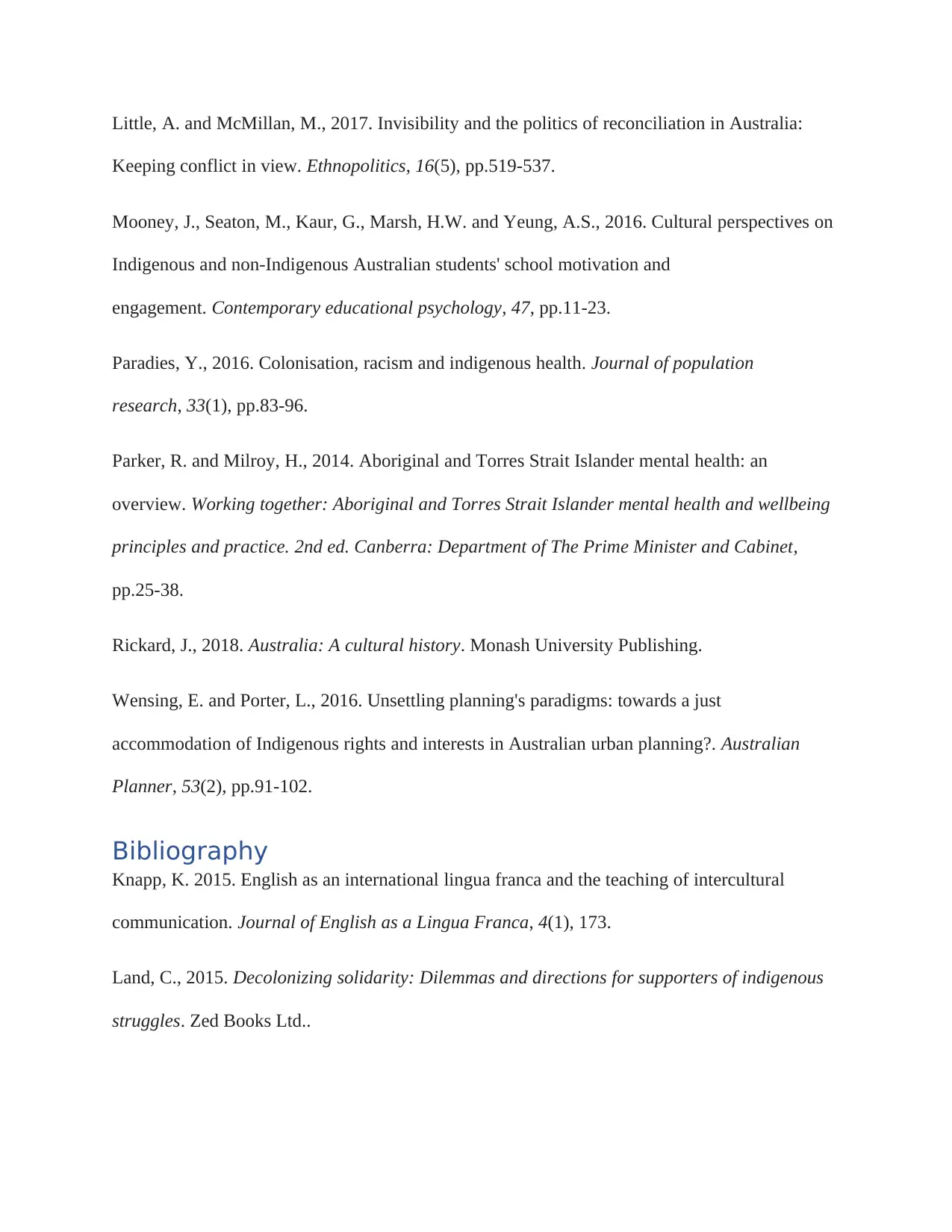
Little, A. and McMillan, M., 2017. Invisibility and the politics of reconciliation in Australia:
Keeping conflict in view. Ethnopolitics, 16(5), pp.519-537.
Mooney, J., Seaton, M., Kaur, G., Marsh, H.W. and Yeung, A.S., 2016. Cultural perspectives on
Indigenous and non-Indigenous Australian students' school motivation and
engagement. Contemporary educational psychology, 47, pp.11-23.
Paradies, Y., 2016. Colonisation, racism and indigenous health. Journal of population
research, 33(1), pp.83-96.
Parker, R. and Milroy, H., 2014. Aboriginal and Torres Strait Islander mental health: an
overview. Working together: Aboriginal and Torres Strait Islander mental health and wellbeing
principles and practice. 2nd ed. Canberra: Department of The Prime Minister and Cabinet,
pp.25-38.
Rickard, J., 2018. Australia: A cultural history. Monash University Publishing.
Wensing, E. and Porter, L., 2016. Unsettling planning's paradigms: towards a just
accommodation of Indigenous rights and interests in Australian urban planning?. Australian
Planner, 53(2), pp.91-102.
Bibliography
Knapp, K. 2015. English as an international lingua franca and the teaching of intercultural
communication. Journal of English as a Lingua Franca, 4(1), 173.
Land, C., 2015. Decolonizing solidarity: Dilemmas and directions for supporters of indigenous
struggles. Zed Books Ltd..
Keeping conflict in view. Ethnopolitics, 16(5), pp.519-537.
Mooney, J., Seaton, M., Kaur, G., Marsh, H.W. and Yeung, A.S., 2016. Cultural perspectives on
Indigenous and non-Indigenous Australian students' school motivation and
engagement. Contemporary educational psychology, 47, pp.11-23.
Paradies, Y., 2016. Colonisation, racism and indigenous health. Journal of population
research, 33(1), pp.83-96.
Parker, R. and Milroy, H., 2014. Aboriginal and Torres Strait Islander mental health: an
overview. Working together: Aboriginal and Torres Strait Islander mental health and wellbeing
principles and practice. 2nd ed. Canberra: Department of The Prime Minister and Cabinet,
pp.25-38.
Rickard, J., 2018. Australia: A cultural history. Monash University Publishing.
Wensing, E. and Porter, L., 2016. Unsettling planning's paradigms: towards a just
accommodation of Indigenous rights and interests in Australian urban planning?. Australian
Planner, 53(2), pp.91-102.
Bibliography
Knapp, K. 2015. English as an international lingua franca and the teaching of intercultural
communication. Journal of English as a Lingua Franca, 4(1), 173.
Land, C., 2015. Decolonizing solidarity: Dilemmas and directions for supporters of indigenous
struggles. Zed Books Ltd..
⊘ This is a preview!⊘
Do you want full access?
Subscribe today to unlock all pages.

Trusted by 1+ million students worldwide
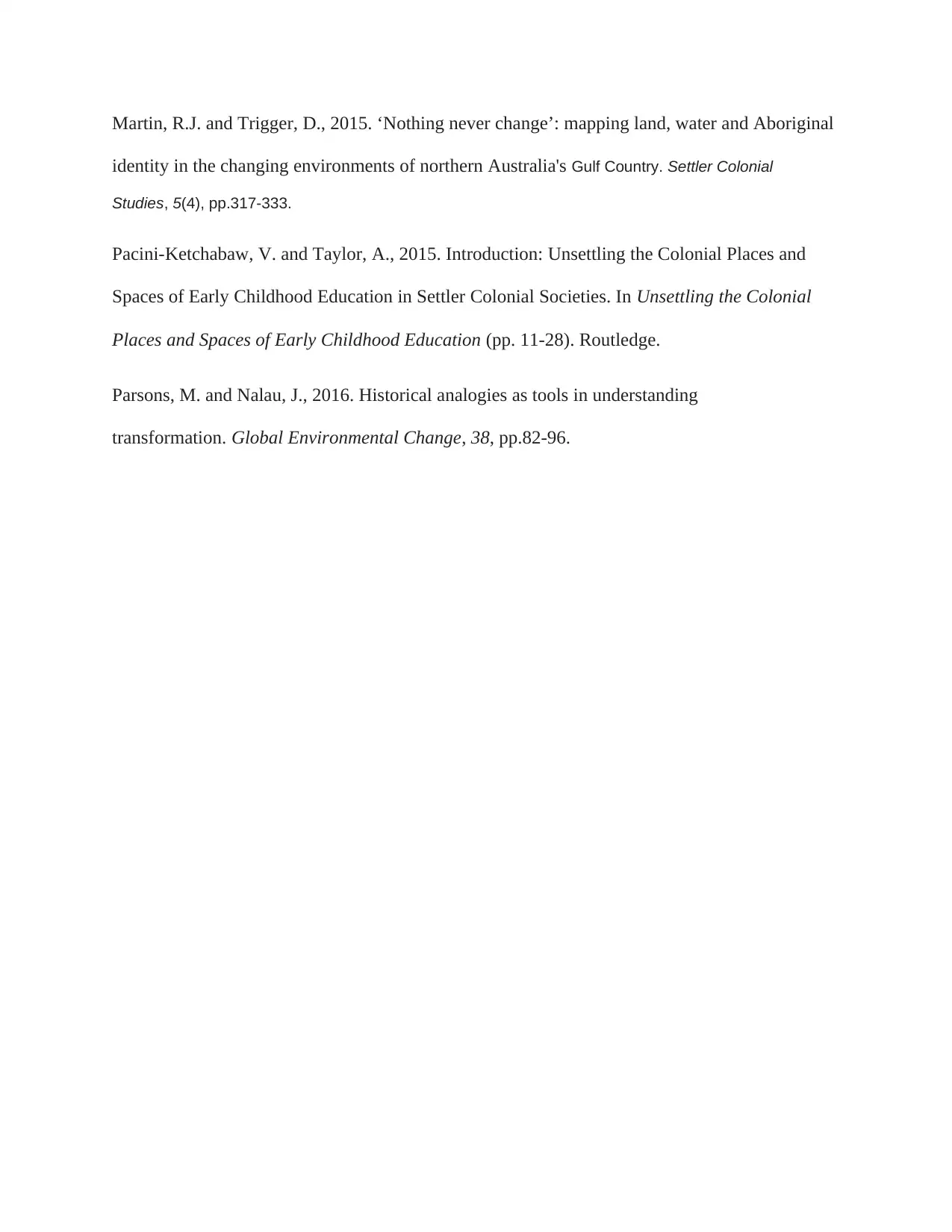
Martin, R.J. and Trigger, D., 2015. ‘Nothing never change’: mapping land, water and Aboriginal
identity in the changing environments of northern Australia's Gulf Country. Settler Colonial
Studies, 5(4), pp.317-333.
Pacini-Ketchabaw, V. and Taylor, A., 2015. Introduction: Unsettling the Colonial Places and
Spaces of Early Childhood Education in Settler Colonial Societies. In Unsettling the Colonial
Places and Spaces of Early Childhood Education (pp. 11-28). Routledge.
Parsons, M. and Nalau, J., 2016. Historical analogies as tools in understanding
transformation. Global Environmental Change, 38, pp.82-96.
identity in the changing environments of northern Australia's Gulf Country. Settler Colonial
Studies, 5(4), pp.317-333.
Pacini-Ketchabaw, V. and Taylor, A., 2015. Introduction: Unsettling the Colonial Places and
Spaces of Early Childhood Education in Settler Colonial Societies. In Unsettling the Colonial
Places and Spaces of Early Childhood Education (pp. 11-28). Routledge.
Parsons, M. and Nalau, J., 2016. Historical analogies as tools in understanding
transformation. Global Environmental Change, 38, pp.82-96.
1 out of 10
Related Documents
Your All-in-One AI-Powered Toolkit for Academic Success.
+13062052269
info@desklib.com
Available 24*7 on WhatsApp / Email
![[object Object]](/_next/static/media/star-bottom.7253800d.svg)
Unlock your academic potential
Copyright © 2020–2025 A2Z Services. All Rights Reserved. Developed and managed by ZUCOL.





